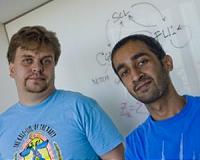 |
Bethesda, Md. (UPI) May 20, 2010 The U.S. National Institutes of Health says its Human Microbiome Project has analyzed 178 genomes from microbes living in or on the human body. The researchers said they discovered novel genes and proteins that serve functions in human health and disease, adding a new level of understanding to what is known about the complexity and diversity of these organisms. The NIH said the human microbiome consists of all the microorganisms that reside in or on the human body. "Outnumbering cells in the human body by 10 to 1, some of the microorganisms cause illnesses, but many are necessary for good health," NIH scientists said. "Currently, researchers can grow only some of the bacteria, fungi and viruses in a laboratory setting. However, new genomic techniques can identify minute amounts of microbial DNA in an individual and determine its identity by comparing the genetic signature to known sequences in the project's data base." NIH Director Dr. Francis Collins said the work is critical for understanding the role the microbiome plays in human health and disease. "We are only at the very beginning of a fascinating voyage that will transform how we diagnose, treat and ultimately, prevent many health conditions," Collins said. The NIH said the Human Microbiome Project, started in 2008, is a $157 million, five-year effort designed to reveal the interactive role of the microbiome in human health. The research appears in the journal Science.
Share This Article With Planet Earth
Related Links The Clone Age - Cloning, Stem Cells, Space Medicine
 Stem Cells: In Search Of A Master Controller
Stem Cells: In Search Of A Master ControllerHouston TX (SPX) May 11, 2010 With thousands of scientists across the globe searching for ways to use adult stem cells to fight disease, there's a growing emphasis on finding the "master regulators" that guide the differentiation of stem cells. New research from Rice University and the University of Cambridge suggests that a closely connected trio of regulatory proteins fulfills that role in hematopoietic stem cells (HSCs), ... read more |
|
| The content herein, unless otherwise known to be public domain, are Copyright 1995-2010 - SpaceDaily. AFP and UPI Wire Stories are copyright Agence France-Presse and United Press International. ESA Portal Reports are copyright European Space Agency. All NASA sourced material is public domain. Additional copyrights may apply in whole or part to other bona fide parties. Advertising does not imply endorsement,agreement or approval of any opinions, statements or information provided by SpaceDaily on any Web page published or hosted by SpaceDaily. Privacy Statement |